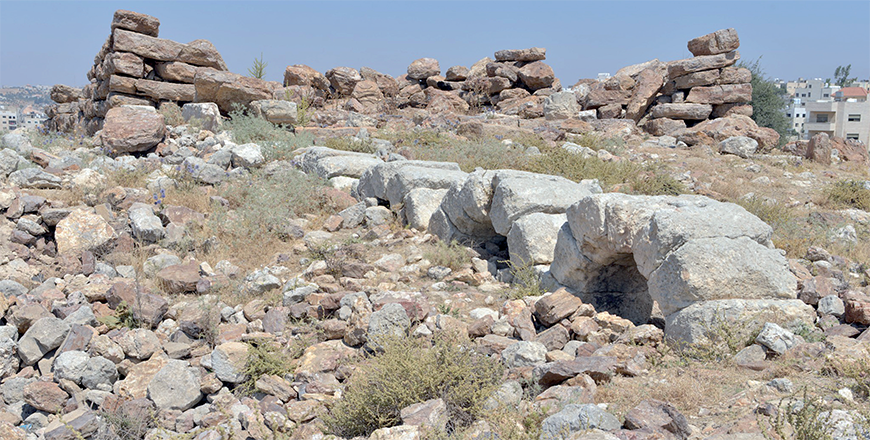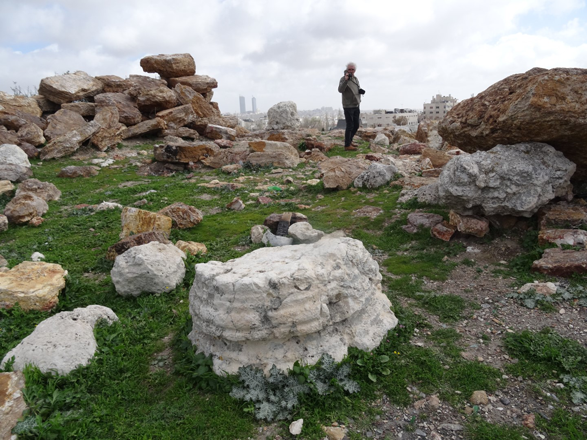You are here
Polish archaeological team surveys remains of Roman watchtower
By Saeb Rawashdeh - Jan 10,2024 - Last updated at Jan 13,2024

An arch at Khirbat as-Sar in Bayader (Photo courtesy of the University of Warsaw Archaeological)
AMMAN — Some archeological sites are inside the most urban areas of Amman, while others are located on its outskirts. Khirbat as-Sar is located in Bayader neighbourhood, on the south-western side of the Capital and it was first recorded by American consul in Jerusalem Selah Merril in 1881.
A few years later, Claude R. Conder (1848-1910), a British explorer, described Khirbat as-Sar as a large site, situated on “the ancient west road from Amman” while “six sarcophagi were found lying in a square enclosure” by the northern side of this road.
Conder described the tower at the site as built “of great blocks of chert or flint”, and to the east of it, he notes “remains of a building with two parallel rows of arches”, remarking that “the piers beneath the arches are covered up”. In his account Conder also mentioned a water pool in the ruins and Roman like masonry.
In 1937, the site was visited by American archaeologist Nelson Glueck who knew it by the name of “Qasr es-Sar”. Glueck gives a detailed description of the site and according to Glueck the square structure was initially a fortress, which was transformed by the Romans into a temple by adding a “platform” on its eastern side, preceded by the courtyard with two rows of arches. Other site structures mentioned by Glueck were “numerous large, now filled-up cisterns and cave cisterns around the site”.
Khirbat as-Sar was a site between the land of Ammon and Gilead which was not excavated in the past.
In a directory of names and geographical sites of the ancient world “Onomastikon”, a Christian theologian Eusebius (260AD-339AD) mentioned Khirbat as-Sar as Azor: “Boundary of the children of Ammon’ [border city of Ammon] which is called Philadelphia now… it is near the west edge of the plateau overlooking the descent to the Jordan River Valley… it occupies the highest point in the vicinity and commands an excellent view over much of the surrounding country-side”.
“From this, it is clear that the site of Khirbat as-Sar must have been a station on the ancient road leading from the Jordan Valley via Wadi Al Kufrein [Kafrein] and Wadi Sir to Rabbat Ammon [Amman]. Therefore, we may propose a plausible identification of Khirbat as-Sar with ‘Birta of the Ammanitis’, mentioned in one of the letters in the Zeno archive,” said Jolanta Mlynaczyk from Warsaw University.
Polish Centre of the Mediterranean Archaeology (PCMA) conducted a survey at Khirbat as-Sar in 2018 and it came to some preliminary results and conclusion.
“The most important results refer to the layout of the temple compound [the ‘qasr’ with its courtyard. In reality, the compound consists of the ‘qasr’, a vestibule and courtyard with two side aisles sectioned off by rows of arcades. The ‘qasr’ was square, built of semi-dressed blocks of flint conglomerate, from big to huge in size,” said Mlynaczyk, adding that two displaced column bases were found inside the “qasr” along with a monolithic base carved together with the column.
According to survey measurements by the PCMA team, the depth of the vestibule amounts to 4.50m while the walls of the vestibule are constructed of mixed material: Huge blocks of flint conglomerate completed with smaller dressed blocks of limestone.
“Conder assigned a general date in the Roman period, while Butler proposed a chronological sequence. He considered the square building to be ‘a structure of great antiquity’, probably a shrine, which was renovated or restored by builders of the Roman period, by the introduction of classic columns and an entablature on the interior,” Mlynarczyk said, adding that Glueck developed this sequence in more detail, identifying the square structure as a fortress and dating it to the Iron Age.
In general, the chronology of the site can be presented from the Iron Age, Persian, Hellenistic, Roman, Late Roman/Byzantine, Umayyad, Abbasside and Mamluk periods, Mlynarczyk underlined.
ffffffff
Related Articles
AMMAN — Khirbat as-Sar is 972m above sea level on the western end of the plateau, commanding access to Rabbat Ammon/Philadelphia (Amman of t
AMMAN — A few years ago, before the outbreak of the COVID pandemic, the archaeological team from Polish Centre of the Mediterranean Archaeol
AMMAN — The Polish archaeological team recently dug at Khirbet as-Sar, a site in Bayader Wadi Sir, on the western outskirts of Amman.



















